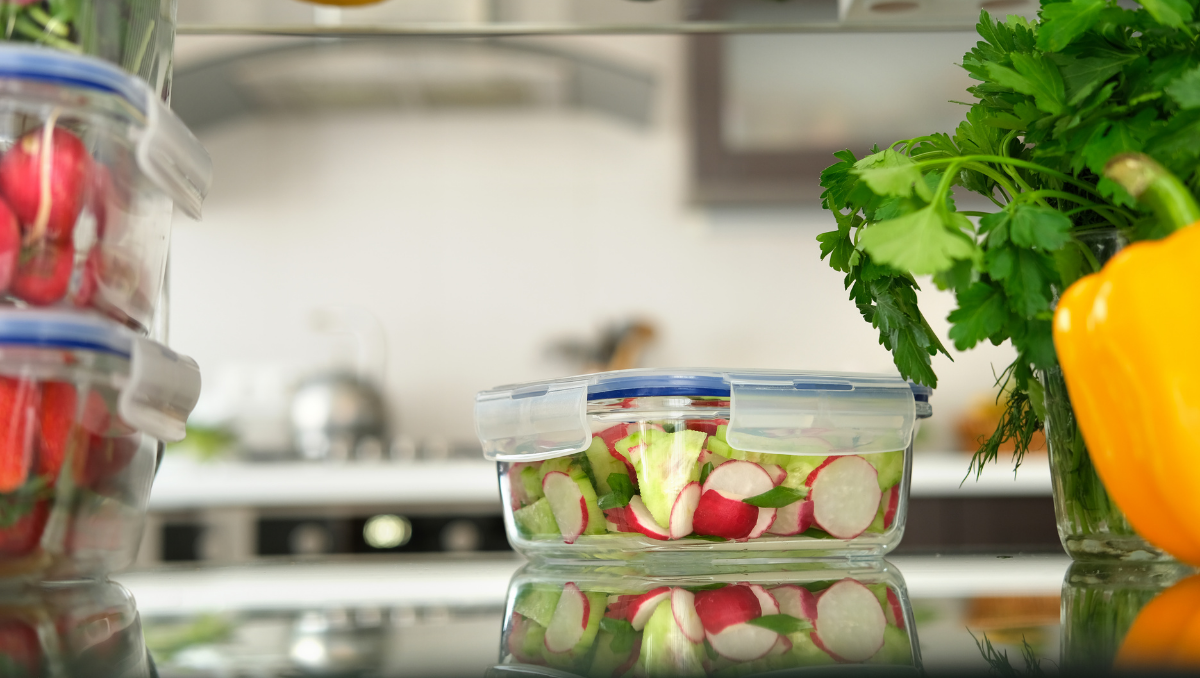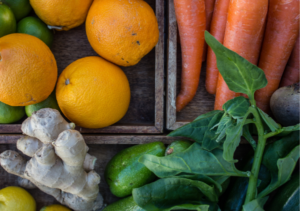
23 Mar 9 Tips for Stocking Your Fridge for Mindful Eating
One of the most important steps to setting yourself up for success with mindful eating is making sure you have foods on hand to support a healthy diet. Understanding what foods to purchase and why will help you make informed decisions at the store and in your kitchen when you’re planning your meals.
Before your next grocery trip or delivery, be sure to read through our list of nine tips for stocking your fridge for mindful eating!
1. Pay Attention to Food Labels
When you’re stocking your fridge, be sure to read the nutrition labels on food. Take note of the suggested serving sizes and how many calories there are per serving. With mindful eating, it’s essential to consider how your body feels as you consume your meals. Knowing what one serving is will help you tune into your hunger and needs.
Look closely at the nutrients listed and their percent Daily Values (%DV). Sodium, saturated fat, and added sugars are critical to watch for, especially in shelf-stable foods. Higher amounts of these nutrients can lead to adverse health effects.
 2. Make Whole, Fresh Foods Your Priority
2. Make Whole, Fresh Foods Your Priority
Whole and fresh foods, such as produce and lean meats, haven’t lost nutritional elements due to processing. They also don’t have added sugars and other unnecessary ingredients. With mindful eating, you can enjoy and contemplate the natural flavors of whole foods.
Whole grains are rich in nutrients like protein, antioxidants, fiber, and Vitamin B. Always choose brown rice, whole wheat and corn tortillas, and 100% whole wheat bread.
3. Choose The Right Fruits
When it comes to fruit, fresh will always be better than canned. Many canned fruits will use sugar-loaded syrups (even if it’s “light syrup”).
Fresh fruits are especially enjoyable with mindful eating since you can savor their natural flavors as part of your eating experience. Be mindful of the natural sugar and carbohydrate content in certain fruits, though. As delicious grapes and cherries are, they are among the fruits with higher concentrations of sugar and carbs.
4. Frozen Fruits and Vegetables Are Great!
Frozen produce is a great option when you have a busy schedule, limited time for food preparation, or if you struggle to use your produce before it starts deteriorating. Produce is typically frozen immediately after harvesting, so the fruits and vegetables maintain their peak nutritional value.
Plus, frozen produce is often inexpensive, making it a healthy option for any budget.
 5. Select Lean Meats
5. Select Lean Meats
As delicious as a juicy steak is, red meat is a food you should eat in moderation. When you purchase red meat, choose lean cuts such as sirloin, tenderloins, and flanks. For ground beef, aim for 95% lean. Try to limit eating red meat to once or twice a week.
If you prefer pork to red meat, lean cuts such as loin chops, sirloin chops, or top loin roasts are the way to go.
6. Fill Your Fridge With Healthy Beverages
Soda and other sugar-filled drinks sure can be tasty, but they don’t do anything positive for your body. You might notice that, with mindful eating, sugary beverages’ initial sweet tastes don’t satisfy you or make you feel your best.
Instead, focus on having water or seltzer available in your fridge. When you can easily reach for something cold and hydrating, you’ll be less tempted to go for a soda.
7. Pick Condiments Carefully
Condiments add delicious bursts of flavor to our meals. However, you’ll want to read their nutrition labels carefully, so you know what they contain before you stock your fridge door with them! Too much of a dressing that’s high in fat, sugar, or sodium can make an otherwise healthy meal unhealthy.
Choose low-fat and low sugar condiments, and when it comes to salad dressings, vinaigrettes made with olive oil are best!
8. Be Mindful of Your Dairy Intake
 It’s essential to consume dairy products in moderation. That’s because, despite their nutritional value, they also have significant amounts of saturated fat.
It’s essential to consume dairy products in moderation. That’s because, despite their nutritional value, they also have significant amounts of saturated fat.
Try to add non-dairy products into the mix, such as those made with soy, almonds, oats, or cashews. If you’re new to dairy alternatives, you may be pleasantly surprised by how tasty many of the available options are.
9. Find Fiber-Rich Foods
Not only is fiber a powerful nutrient that lowers cholesterol and supports weight management, but it helps you feel full longer. When you’re focusing on mindful eating and listening to your body’s hunger or fullness, consuming more fiber is especially helpful as you learn to tune into those sensations. Try to get at least 25mg every day!
Want to learn more about how you can set yourself up for success with mindful eating? Don’t miss The Basics of Healthy Eating workshop with Carly on March 25! You’ll learn everything you need to know about choosing and eating healthy foods, including what foods to eat/avoid, portion control, and more. You’ll also receive a reusable VIBE canvas grocery bag and shopping list with registration! Sign up today!





